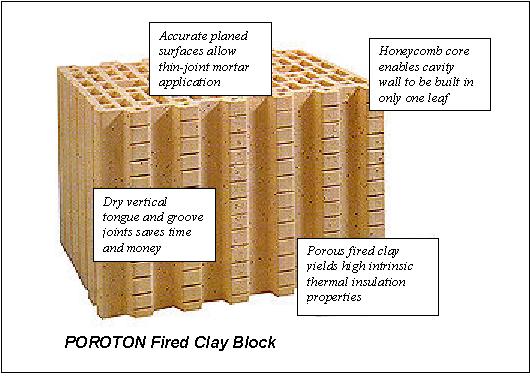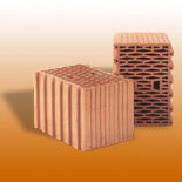What is Poroton?
'Poroton' is the trade name for a fired-clay block (or 'jumbo
brick') manufactured to a high degree of accuracy. These blocks
are formed with a honeycomb structure of vertical perforations,
that reduce the material in the block (and thus the weight), whilst
maintaining adequate strength and increasing the thermal resistance
(lambda value) of the block. The non-face ends of the brick are
keyed with vertical tongue & groove, eliminating the need
for mortar between vertical faces. The high accuracy to which
the block is finished makes in suitable for use with thin-joint
mortar. Additional thermal resistance is possible, if the clay
has been mixed with sawdust before firing, resulting in micro-pores
in the finished block, and most suppliers offer such a 'thermal
block'. The inner and outer face of the block is keyed ready to
accept plaster.

Due to the accuracy of the blocks manufacture (a tolerance of
better than one millimetre), Poroton blocks are suitable for thin-joint mortar systems,
leading to a decrease in construction time, reduced mortar usage,
better accuracy and higher thermal resistance (U-value)
of the finished wall. Poroton blocks can be readily chased to
accept wiring, can be easily cut accurately on site, and allow
secure attachments to be made into the wall (pictures, shelves,
etc).
In widespread use in mainland Europe for over fifty years -
in Germany one in every four houses is built of Poroton blocks.
Using Poroton, it is relatively economic to achieve the insulation
levels of a 'passive' house (U-value better than 0.2 W/m2K- that
is, one that does not need a central heating system). Even with
100mm of high-quality insulation, a conventional cavity wall would
have to be over 1m thick to equal a 0.48m Poroton single leaf
wall. Poroton can also be used in cavity walls and in conjunction
with an exterior insulation/cladding system, to achieve high values
of insulation.

Use of thin-joint mortar in constructing Poroton walls also helps
to reduces heat loss as a smaller proportion of the wall's face
is composed of mortar - which has less favourable thermal properties
than the block. The single leaf wall is faster to build both because
only one leaf is required and because thin-joint mortar can be
used. The insulation applied externally is both faster and less
prone to cold bridging as it covers all elements equally.

